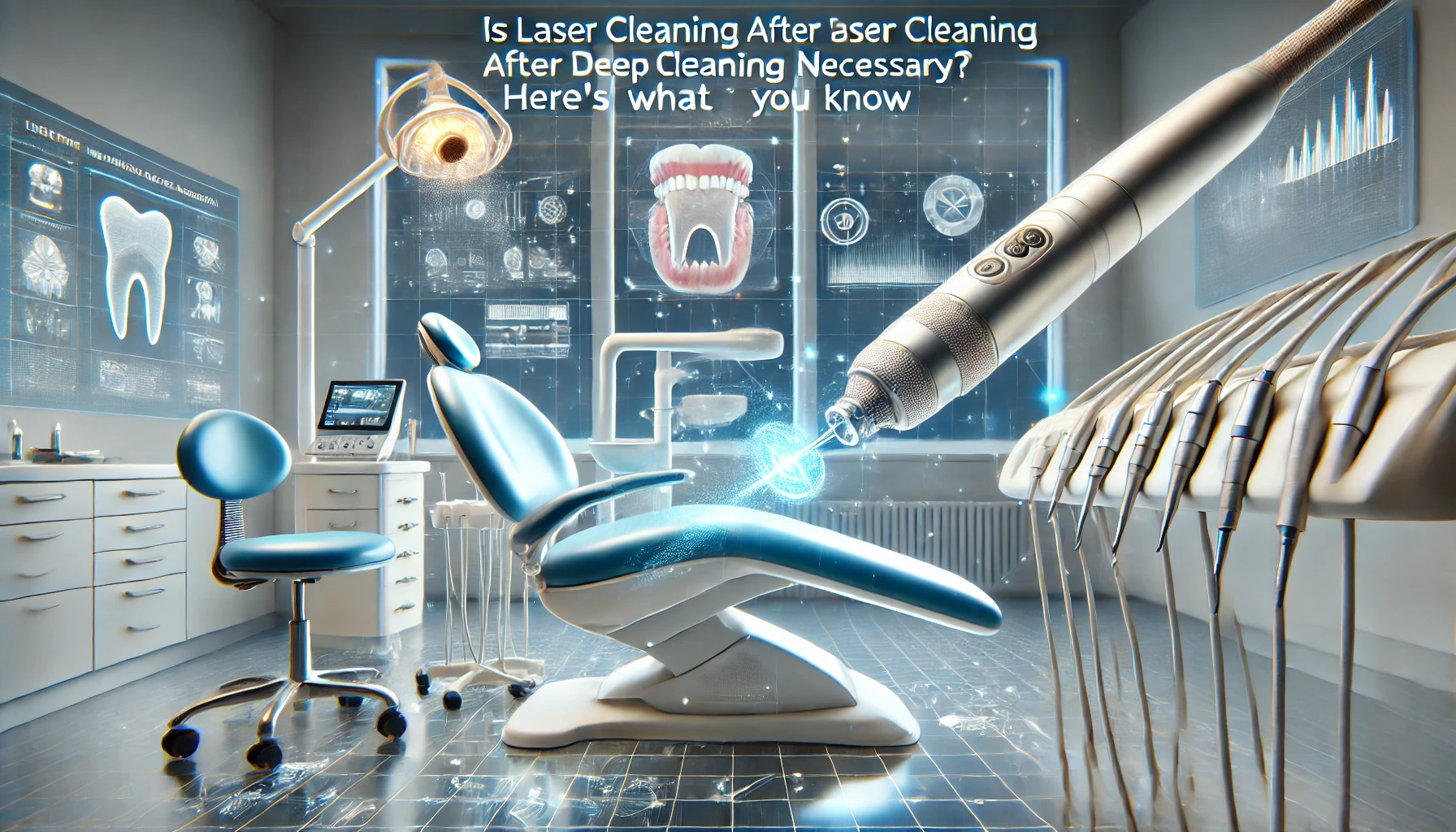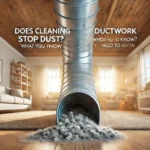- Introduction: What Is Deep Cleaning and Why Is It Important?
- Understanding Laser Cleaning in Dentistry
- Is Laser Cleaning After Deep Cleaning Necessary?
- Benefits of Laser Cleaning After Deep Cleaning
- Who Can Benefit from Laser Cleaning After Deep Cleaning?
- Laser Cleaning vs. Traditional Cleaning: Which Is Better?
- Risks and Considerations for Laser Cleaning
- How to Decide If You Need Laser Cleaning After Deep Cleaning
- What to Expect During a Laser Cleaning Procedure
- Conclusion:
Introduction: What Is Deep Cleaning and Why Is It Important?
Deep cleaning is a dental procedure that focuses on cleaning below the gumline to treat gum disease. Unlike a regular cleaning, which focuses on the surface of the teeth, deep cleaning goes deeper to remove plaque and bacteria from hard-to-reach areas.
Scaling and root planing are the two main steps in deep cleaning. During scaling, the dentist removes plaque and tartar buildup from the tooth’s surface and below the gumline. In root planing, the dentist smooths the tooth roots to help gums reattach to the teeth, preventing further buildup of bacteria.
Deep cleaning is crucial for maintaining gum health, especially for people with gum disease, also known as periodontitis. If left untreated, gum disease can lead to tooth loss and other health problems. Deep cleaning helps stop the progression of gum disease, keeping your gums healthy and strong.
Understanding Laser Cleaning in Dentistry
Laser cleaning is a modern dental technique that uses concentrated light energy to remove plaque, bacteria, and infected tissue from the gums and teeth. Instead of traditional tools like scalers or curettes, lasers are used to target problem areas with precision.
How laser cleaning works is simple. The laser beam is directed at the affected area, removing harmful bacteria and tissue while leaving healthy parts untouched. The laser energy also helps seal the gums, reducing bleeding and swelling. This makes it less invasive compared to traditional deep cleaning methods.
There are several benefits of using laser technology in dental care. Lasers offer a more comfortable experience for patients. They can reduce pain, bleeding, and the need for anesthesia. Additionally, lasers promote faster healing by encouraging the growth of healthy tissue. For patients with gum disease or sensitive gums, laser cleaning is a more gentle and effective option. It’s also useful for reaching areas that are hard to clean with traditional methods.
Is Laser Cleaning After Deep Cleaning Necessary?
The question “Is laser cleaning after deep cleaning necessary?” depends on each patient’s dental health. Laser cleaning is often recommended after deep cleaning if gum disease is more advanced or if traditional deep cleaning doesn’t fully solve the issue. Dentists may suggest laser cleaning to ensure deeper pockets of infection are thoroughly cleaned, especially when bacteria remain in hard-to-reach areas.
When comparing traditional deep cleaning methods vs. laser cleaning, traditional methods rely on manual tools to remove plaque and tartar. While effective, these tools may not always reach deep enough, and patients often experience more discomfort and bleeding. Laser cleaning offers a more targeted approach, removing bacteria without causing as much trauma to the gums. Patients report less pain and faster healing with lasers compared to traditional methods.
There are certain cases where laser cleaning enhances the effectiveness of deep cleaning. For example, in patients with severe gum disease or deep gum pockets, lasers can access and sterilize areas that may be missed with manual tools. Laser treatment can also reduce the chances of infection returning, making it a great follow-up to traditional deep cleaning for those who need extra care.
Benefits of Laser Cleaning After Deep Cleaning
Laser cleaning after deep cleaning offers several key advantages for improving oral health. One of the biggest benefits is better removal of bacteria and plaque. Traditional deep cleaning can miss some bacteria in hard-to-reach areas, but lasers can target these spots with precision, helping to ensure a more thorough cleaning.
Another major benefit is the enhanced healing of gum tissue. Lasers not only clean but also promote faster recovery by stimulating healthy tissue growth. This can lead to stronger, healthier gums after the procedure.
Reducing gum inflammation and bleeding is another advantage of laser cleaning. Since lasers are less invasive than traditional tools, they cause less trauma to the gums. This means less swelling and bleeding during and after the procedure, making the recovery process smoother.
Patients also report less pain and discomfort compared to traditional methods. Laser cleaning is gentler on the gums, often reducing the need for anesthesia. Many patients feel more comfortable during and after the procedure, making it a popular choice for those with sensitive gums or anxiety about dental work.
Who Can Benefit from Laser Cleaning After Deep Cleaning?
Laser cleaning after deep cleaning can be especially beneficial for certain groups of people. Patients with severe gum disease (periodontitis) are often ideal candidates. Since periodontitis causes deep infection in the gums, laser cleaning can help target bacteria and promote healing in areas that are difficult to treat with traditional methods.
Patients prone to recurring infections may also benefit from laser cleaning. For individuals who struggle with keeping gum infections under control, laser cleaning provides a more thorough and precise way to remove harmful bacteria, reducing the likelihood of future issues.
Individuals with deep gum pockets that are hard to clean with traditional methods can also gain from laser cleaning. Deep pockets in the gums can harbor bacteria that are difficult to reach with regular dental tools. Lasers can penetrate these pockets more effectively, ensuring a more complete cleaning.
Lastly, patients seeking a more comfortable dental experience often prefer laser cleaning. The procedure is less invasive, with less pain, swelling, and bleeding compared to traditional deep cleaning methods. This makes it a great option for people who may have dental anxiety or sensitivity.
Laser Cleaning vs. Traditional Cleaning: Which Is Better?
When deciding between laser cleaning and traditional cleaning, there are a few important factors to consider.
First, let’s look at recovery time and patient comfort. Laser cleaning tends to offer a quicker recovery compared to traditional methods. Since lasers are less invasive, patients often experience less swelling, bleeding, and discomfort. Traditional cleaning, which uses manual tools, can cause more gum irritation and may require a longer healing period. For people who want a smoother, more comfortable experience, laser cleaning is often the preferred choice.
In terms of long-term results, both methods are effective at treating gum disease and maintaining oral health. However, laser cleaning may offer some additional benefits. Lasers can more accurately target infected areas, leading to more thorough cleaning and less chance of bacteria returning. This can result in better gum health over time, especially for those with severe gum disease.
When it comes to cost differences and insurance coverage, laser cleaning is typically more expensive than traditional cleaning. The cost reflects the advanced technology and specialized skills required to perform the procedure. However, some insurance plans may cover laser cleaning, especially if it’s deemed medically necessary for treating gum disease. It’s always a good idea to check with your dentist and insurance provider to understand your coverage options.
Risks and Considerations for Laser Cleaning
While laser cleaning offers many benefits, it’s important to understand that, like any procedure, it comes with some risks. However, the risks associated with laser cleaning are generally low. One potential concern is that, if not performed correctly, the laser could damage surrounding tissues. This is why it’s crucial to have the procedure done by an experienced dentist who specializes in laser technology.
There are also possible side effects to consider, though they tend to be mild. These can include slight discomfort, minor swelling, or sensitivity in the treated areas. However, when compared to traditional methods, laser cleaning generally causes less pain and inflammation. The recovery period is usually faster, and the overall experience is more comfortable for most patients.
Before deciding on laser cleaning, patients should know a few key things. First, not all dental issues can be solved with lasers, and some patients might still require traditional methods for certain treatments. Additionally, as mentioned earlier, laser cleaning may come at a higher cost than regular deep cleaning, and insurance coverage can vary. It’s essential to have a conversation with your dentist to see if laser cleaning is the right choice for your specific dental needs.
How to Decide If You Need Laser Cleaning After Deep Cleaning
Deciding if laser cleaning after deep cleaning is necessary depends on several important factors. One key factor is the severity of gum disease. If your gum disease is advanced, with deep pockets of infection, laser cleaning can help by reaching areas that traditional cleaning might miss. It can also speed up the healing process and reduce the risk of future infections.
Another factor to consider is patient comfort. If you’re someone who experiences anxiety or discomfort during dental procedures, laser cleaning may be a better option. Lasers are less invasive and cause less bleeding, swelling, and pain compared to traditional tools, making the overall experience more comfortable.
Cost is also something to think about. Laser cleaning is usually more expensive than traditional methods due to the technology involved. It’s important to weigh the benefits against the cost and check with your dental insurance provider to see if laser cleaning is covered.
Before making a decision, it’s always best to consult with your dentist. They can provide personalized advice based on the condition of your gums and your overall oral health. A dentist can assess whether laser cleaning is necessary in your case and explain the potential benefits and risks.
Looking at case studies or examples of patients who benefited from laser cleaning can also help. Many patients with severe gum disease or those prone to recurring infections have reported better outcomes after laser cleaning. Hearing their experiences can give you more confidence in deciding if this option is right for you.
What to Expect During a Laser Cleaning Procedure
If you’re considering laser cleaning after deep cleaning, it helps to know what the process involves. Here’s a simple step-by-step explanation of what you can expect during the procedure:
- Preparation: Your dentist will first examine your teeth and gums to identify the areas that need treatment. You may receive a mild numbing gel to ensure you stay comfortable during the procedure.
- Laser Treatment: The dentist will use a specialized laser tool to target the affected areas. The laser emits concentrated light energy, which helps remove plaque, bacteria, and infected tissue from your gums. The process is precise, focusing only on the problem areas without harming surrounding healthy tissue.
- Gum Sealing: After cleaning, the laser helps to seal the gums, reducing the chances of infection and promoting faster healing. This step is quick and painless.
So, how does laser cleaning feel for patients? Most people report feeling little to no discomfort during the procedure. The laser itself creates a mild sensation, but it’s far less invasive than traditional tools. Since there’s no cutting or scraping involved, you’re less likely to experience the pain or sensitivity that comes with traditional deep cleaning.
In terms of recovery time and post-treatment care, laser cleaning offers a quicker recovery. Since the laser reduces gum trauma, patients usually experience less swelling and bleeding. You can expect to heal faster and resume your normal activities sooner. After the procedure, your dentist will give you simple aftercare instructions, such as avoiding certain foods and practicing good oral hygiene to maintain the results.
Conclusion:
In conclusion, laser cleaning after deep cleaning can be a highly effective option for certain patients, especially those with severe gum disease or hard-to-reach areas that traditional cleaning may not fully address. The benefits of laser cleaning, such as better removal of bacteria, reduced discomfort, faster healing, and less invasive treatment, make it an appealing choice for many. Additionally, for patients who seek a more comfortable and less painful dental experience, laser cleaning offers significant advantages over traditional methods.
Ultimately, whether laser cleaning is necessary after deep cleaning depends on individual needs. Consulting with your dentist is essential to determine the best course of action. If your gum health requires extra care, or if you’re looking for a quicker, more comfortable recovery, laser cleaning may be the right solution for you. Always weigh the benefits, cost, and advice from your dental professional to make an informed decision.
Thank you for visiting our Blog! For more engaging content, please check out the related category.





